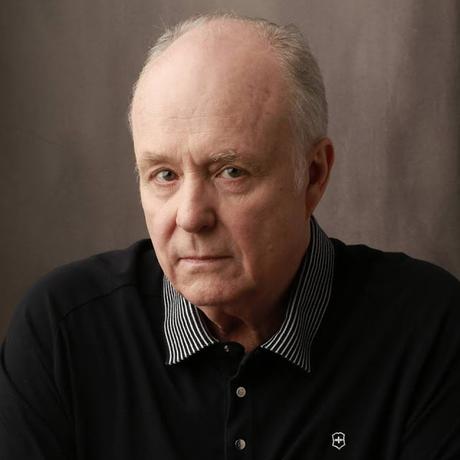
John McNaughton: Through the Cinematic Past, Darkly
By Alex Simon
John McNaughton was born in Chicago, attended the University of Illinois at Urbana as a
fine arts major and graduated from Columbia College, Chicago with a degree in
television production and still photography.
Before becoming a filmmaker he worked at numerous occupations including: layout artist
Encyclopedia Britannica, Timekeeper, Chicago Bridge and Iron, Railroad Switchman,
Republic Steel, Printer, Pullman Bank, Auto Worker, International Harvester Company,
Audio/Visual Specialist, Campbell Mithun Advertising and on to carnival barker, jewelry
maker, sailboat builder, bartender, union carpenter and operator of a laser light show.
McNaughton then worked in commercial film & video production eventually, meeting
Waleed and Malick Ali, owners of a fledgling video distribution company (MPI), who
distributed his first documentary, DEALERS IN DEATH. Two years later MPI funded
his first feature film, HENRY: PORTRAIT OF A SERIAL KILLER which McNaughton
directed, co-wrote, and co-produced. Completed in 1986, numerous complications
plagued the controversial film and it was not released theatrically until 1991. When
finally released, Elliot Stein of the Village Voice named it the best film of the year and it
made the ten best lists of both Time Magazine and Roger Ebert. The film also won best
picture honors at film festivals in Spain and Belgium.
At this time McNaughton was signed by The Gersh Agency who brought HENRY to the
attention of Martin Scorsese. Mr. Scorsese hired McNaughton to direct MAD DOG AND
GLORY for Universal Pictures, starring Robert DeNiro, Bill Murray and Uma Thurman.
Since then, McNaughton has worked continuously directing feature films, TV pilots,
episodic television and documentaries and occasionally in theater.
Among his many credits are feature films including WILD THINGS, directed for Sony
Pictures and Mandalay Entertainment starring Matt Dillon, Kevin Bacon, Bill Murray,
Neve Campbell, and Denise Richards, and LANSKY for HBO Films written by David
Mamet and starring Richard Dreyfus and Anthony LaPaglia. Additionally, McNaughton
directed five episodes of the NBC television show, HOMICIDE: LIFE ON THE
STREETS, the pilot for the ABC series PUSH NEVADA, written by Ben Affleck and
Sean Bailey, and the documentary CONDO PAINTING for October Films, featuring the
final appearances of both Allen Ginsberg and William S. Burroughs. Most recently he
directed the feature film THE HARVEST, starring Academy Award nominees, Michael
Shannon, Samantha Morton and Peter Fonda.
McNaughton’s biggest commercial hit to date was 1993’s MAD DOG AND GLORY, which is receiving a 25th anniversary Blu-ray release from Kino Lorber. Packed with extras, including a commentary track from McNaughton who dishes some great behind-the-scenes anecdotes, it’s a fitting way to revisit one of the Clinton era’s most charming sleepers. Written by Richard Price (THE WANDERERS), MAD DOG AND GLORY streets on March 5th.
John McNaughton spoke with The Hollywood Interview via Alexander Graham Bell from his home in Chicago recently. Here’s what was said:
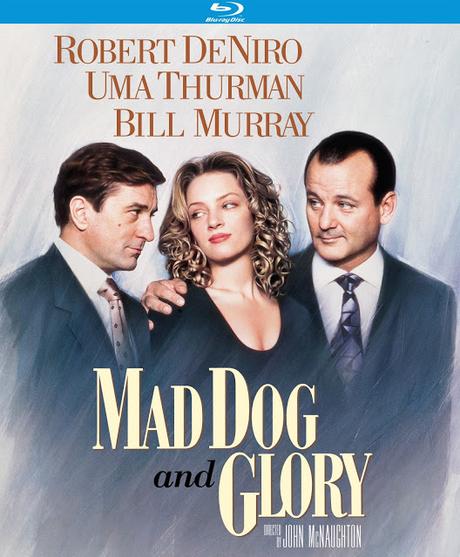
It was great fun watching MAD DOG AND GLORY again. I’d forgotten what a blend of genres and tones it was. In the wrong hands, it could’ve been a misfire, but you made it all work.
John McNaughton: Well, and Richard Price is an amazing writer. Except for the ending, we left it alone.
Did the script belong to Martin Scorsese originally, then he approached you?
Yeah, and for a brief moment before I got involved, Ron Howard was going to do it. I’m glad he passed. (laughs)
Did you know Scorsese beforehand?
No, although I’d been a huge fan since seeing MEAN STREETS when it was first released, in ’73. I remember going to see it with all my buddies from the South Side (of Chicago). It was like watching a home movie about ourselves, even though it was about guys from Little Italy, in New York. We’d never seen anything like it. We were punks from the city, and I remember thinking, ‘Gee, you can make a movie like this, about guys like us?’ It was a revelation.
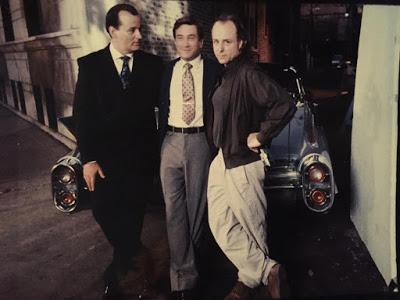
One thing that struck me while watching MAD DOG, then revisiting HENRY, for our talk is that it’s always bothered me that people have tried to shoehorn you as a “horror director,” which you’re certainly not. If anything, you’re a Neo-Realist. Both MAD DOG and HENRY have much more in common with BICYCLE THIEVES and LOOK BACK IN ANGER than they do FRIDAY THE 13th.
Thank you and I agree. Those movies you mention were the ones I grew up watching on television, on WGN, and again, they were about people like me and those I grew up with: working class people from the inner city. MEAN STREETS was really the first American version of that sensibility. I liked horror movies growing up, but I was never one of those kids who were obsessed with them, with what I call “Oooga-Booga Horror.” Of that genre, the original NIGHTMARE ON ELM STREET is really good, I think, just a spectacular, very smart example, but so not a film I could ever conceive of making. But the supernatural really doesn’t interest me very much, unless it’s of the Henry James variety. Film Noir is what really grabbed me as a kid, anything shot at night really spoke to me.
And HENRY is almost like a black & white film, shot in color. It’s very desaturated.
Oh yeah, that was intentional. It’s as noir as a color film can be.
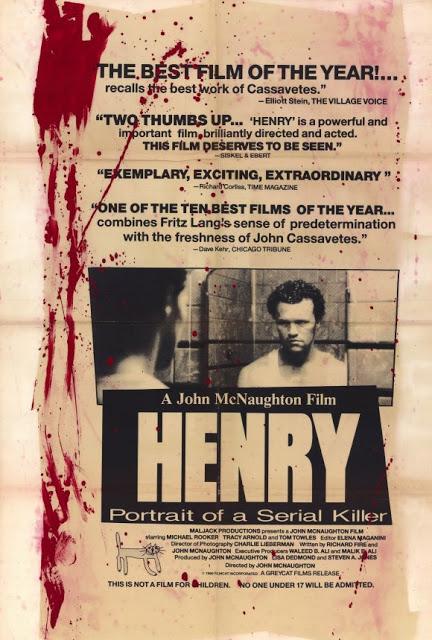
And it felt like all of your actors were people you literally pulled off the floor of a factory, or the unemployment line.
Well, it’s interesting, Michael Rooker was born in a little town called Jasper, Alabama, then when his parents split up, they moved to a suburb of Chicago called Cicero, where his dad was a gofer for a local mobster. So Michael, who’s actually a very warm, outgoing, funny guy in real life, knew first-hand about the dark, sort of subterranean world that people like Henry and Otis occupied.
You retained that offbeat sensibility in MAD DOG. Uma Thurman, who was still a relatively new face at this point, isn’t a classic beauty by any means. She’s very offbeat, and one-of-a-kind, not to mention that you cast against type with Bill Murray as the mob boss and De Niro as the dorky forensics cop who’s still an insecure teenager, at heart.
We had a reading where we read the script twice, in Manhattan. We did it at Bob’s offices, in Tribeca. Bob read both parts, and then when Bob read the cop, Wayne Dobie, Christopher Walken read the Bill Murray part. He was amazing! I wish I’d recorded it. It was just crazy.
I remember upon first viewing in ’93, I realized what a versatile actor Bill Murray is. He was alternately charming and terrifying in this.
Well, Bill is a tough Irish kid from Chicago. You would not want to get into a fistfight with Bill Murray, trust me. In fact, in the final fight between he and Bob, Bill accidentally broke Bob’s nose with that first punch. So yeah, he really retains that toughness in certain roles and Bob, too, was a tough kid from Greenwich Village, which we’ve seen in many roles he’s played. It’s funny, I’ve started teaching at Second City, in their new film school named after Harold Ramis, and it’s been great fun, but, and I can’t believe I’m about to say this, kids today…it’s like they’ve been protected their whole lives. We’re talking about fight scenes and I’ve found myself saying ‘Wait a second, haven’t any of you guys ever been in an actual fight?!” And usually the answer is “no,” which is too bad, quite frankly. You learn a lot about yourself and about life when you find yourself in a good, old-fashioned street fight.

Yeah, I think our two generations, the Boomers and Gen-X, were raised very similarly: don’t come home until the street lights are on and don’t get killed. It was a foregone conclusion that along the way we were going to get a few bumps and bruises not to mention donate a few pints of blood. Not so with the Millennials.
That’s for sure. I grew up in a town called Roseland, which not only a misnomer if there ever was one, but it was the last town you’d come to on Chicago’s South Side, which is a notorious place, and has been for years. And yeah, if you wanted to survive, to stay in one piece, you had to know how to use your fists. Maybe we’re becoming kindler and gentler, but I doubt it.
What did your parents do? You were an only child, right?
Yeah, an only child, and the only advantage was during Christmastime. The rest of the year it was “Hmm, somebody broke the lawn mower. Who could it be?” (laughs) My dad did many things. When I was born, he settled into a job selling insurance to the people who worked in the steel mills. He wore a suit and tie and sold life insurance to the people he grew up with. My mother stayed home until I was in high school. Her great passion was clothes, but she was poor as a girl, but was quite beautiful, and she made her own clothes. She always dressed beautifully. She eventually got a job at a women’s wear store on “The Ave.” And she loved working there, because she’d wait until everything went on sale, then buy it for like five bucks. We were upper lower middle class, if that makes any sense. My parents were “strivers,” people who wanted their kids to go to college, even though they hadn’t, so they could have better lives.
Let’s get back to MAD DOG. This was your first A-list picture, after a rapid rise once HENRY started getting ink.
I had a baptism by fire with my next picture after HENRY, which was called THE BORROWER. It was about an alien whose head explodes upon reaching the Earth and goes around tearing humans’ heads off and affixing them to his own neck stub. To put it mildly, everything that could possibly go wrong on this show, did, with every Hollywood dirty trick in the book pulled on us. We had to go to a completion bond company to finish the movie…it was just awful. Anyway, I was sitting in my old loft, on Milwaukee Avenue, got a call from Scorsese’s development person, a woman named Melanie Friesen. She said that Marty had seen HENRY and wanted to talk to me. So I talked with Marty and sent me Price’s script for MAD DOG. After HENRY, and after I got an agent, I started to get tons of scripts sent to me, almost all of which were bargain-basement horror scripts, just an assembly of clichés. I passed on them all. With MAD DOG, I realized I had the opportunity to do something different. And after reading so many bad scripts, it was just such a pleasure to read Richard Price’s words.
What was it like for a young director working with an icon like Robert De Niro, were you intimidated?
No, because in person he’s very low-key. He was very kind to me and we had two weeks of rehearsal before we shot. So by the time we were on the set, we knew each other and were of one mind as to the story we were telling. The first time I had to adjust him: “No, that doesn’t work. Try it like this,” I did think in the back of my head: “Holy shit, I just told Bob De Niro what to do.” (laughs) But he was amenable to everything, very easy to direct and work with.
You have a few other actors in the film I’ve always found fascinating. Tell me about David Caruso.
David, interestingly, we were having a very hard time casting that part. I’ve found that there’s always one part that’s impossible to cast. I really wanted Rooker in that role. Marty gave me pretty much free reign in everything I did, but he pulled rank and said “Rooker has the wrong speech pattern. He’s a southerner.” The piece was originally written for New York, but we moved it to Chicago, where we had Appalachians assimilated everywhere, which you don’t have in New York. So I decided to see his point. We had read Caruso, along with a ton of other people. Marty said “That guy’s like an Irish cop, he’s perfect.” The only problem is that David showed up the day before shooting began and wasn’t in rehearsals with us. Rehearsal is everything to me. It saves so much time and pain, because you work out all the problems before the cameras start rolling and the money starts flying out the window. So he was in a different movie in the first few days of shooting, and it wasn’t working. Eventually, we worked it out and David was terrific, just knocked it out of the park. And it was a real career-maker for him, and he wound up getting cast in NYPD BLUE out of MAD DOG.
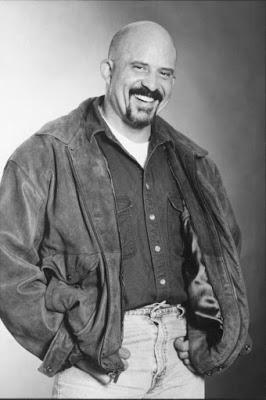 The late Tom Towles, who co-starred in both HENRY and MAD DOG AND GLORY.
The late Tom Towles, who co-starred in both HENRY and MAD DOG AND GLORY. We have to talk about Tom Towles, who was in both MAD DOG and HENRY.
Oh, dear Tommy. He’s gone now, you know, a few years ago. Had a stroke. In fact, on my Facebook page I have a picture of Steve Jones, my producing partner, and I scattering Tommy’s ashes in Lake Michigan. Tommy was an interesting guy. He was half-Black. His father was Caucasian and his mother was African-American, and he grew up on the South Side of Chicago. So, it wasn’t an easy path for Tommy. There was a wonderful theater company in Chicago back in the day called The Organic. Richard Fire, who co-wrote HENRY was in that company, as were Tommy, Tracy Arnold, Dennis Franz, Dennis Farina, Joey Mantegna, all these great Chicago actors. So I hired Tommy because he could play a sleaze so well. But I hadn’t really seen Tommy on the stage. After he died, Tommy’s sister organized his memorial. They put on this slide show, almost entirely of Tommy in the theater, and he was amazingly versatile! He was nothing like the lowlife types he played in the movies. I just loved Tommy. He was a big goof, in a way, but also very smart. He was very lovable as a human being. He joined the Marines at 18, but also had asthma. He’d been lifting weights since he was young, and he really loved to ride his bike everywhere, big bike-rider. So one night, he’s out riding his bike and this cab driver cuts him off, makes him crash, and he chases the cab driver down, and pistol-whips the cab driver! He was not a guy you wanted to cross.
You made an interesting comment on the MAD DOG commentary track during the scene where he and Caruso face down in the bar: “If that had gone done in real life, it would’ve gone down much differently.”
(laughs) Yes, to say the least. He didn’t look for trouble, but you didn’t want to mess with him, either.
You also have one of my favorite actresses, Kathy Baker, in the movie.
Yeah, that was a Bob recommendation. He’d just worked with her on JACKKNIFE, with Ed Harris, where they played Vietnam vets. Bob just raved about her, and he was right.
Let’s talk about HENRY. It’s, to this day, the most sobering film I’ve ever seen, as much as Pasolini’s SALO. How did it all begin?
I was working at my cousin’s bar at night and working for the Ali brothers (who wound up producing HENRY) in their video business during the day, delivering audio-visual equipment. Home video hadn’t quite been invented yet. We said “One day we’re gonna make a movie together.” That was the goal. So, time went on, and I reminded them: “Do you remember when you said we were going to make a movie together?” And they said they’d give me $100,000 to make a horror film, because those low-budget, B-horror films were very hot in (the ‘80s). I had no idea what to do. I just wanted to make a film, not necessary a horror movie. Richard Fire, who was my writing partner, didn’t want to do it, because he thought it was beneath him. He was a “theater guy” with a master’s degree, but we decided to tackle it anyway. We had $100,000 so we knew it wasn’t going to be a sci-fi epic with special effects, but we decided that we had to absolutely come up with a way to redefine what “horror” was and utterly horrify an audience. We decided the number one way was to remove the fantasy element. So that’s what we did.
As we said earlier, HENRY is a neo-realist picture, not a horror film.
Yeah, I agree. It’s about blue collar guys and their world. They just happen to be serial killers. It’s a European art film stylistically, emotionally and technically. It’s not slick and entertaining. It’s about human behavior and the human condition, primarily. We wanted to go for a different approach.
Tracy Arnold was so fascinating to watch, had a very unique quality. I remember thinking when I first saw the film that she had to have a great career ahead of her, then she just vanished. Did she decide to leave the business to raise a family? What happened there?
No. She decided that as soon as we had wrapped, before the film was even released, that she was going to Hollywood. I sort of advised her against it. I said ‘If this film makes a mark, Hollywood will come to you. But if you go there, approach people directly, and are perceived as being “needy,” you’re going to go through hell.’ So the film finally came out in LA and it made a big splash. I was at the LA premiere of the movie. There was a dinner after the screening. I got back to my hotel, which was not the Four Seasons, I might add (laughs), this was before voice mail, and they had message slips. I literally had sixty message slips waiting, forty-nine of which were from agents. So Tracy went out to LA and started working at this hamburger joint on Highland. Everyone recognized her, had her in for auditions, but people were so unsettled by the fact she was the girl from HENRY, they didn’t cast her. She ended up moving back to Texas, where she still is today. She runs a theater there, in Houston. She looks like she’s enjoying her life.
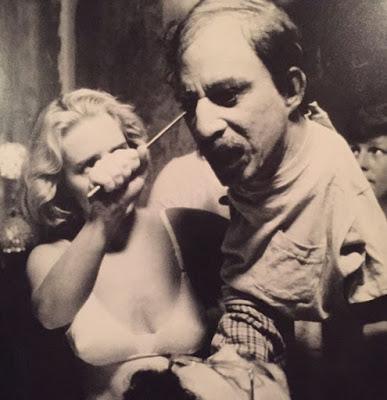 Tracy Arnold, about to deliver the coup de gras to her brother Otis (Tom Towles, his prosthetic version), in HENRY.
Tracy Arnold, about to deliver the coup de gras to her brother Otis (Tom Towles, his prosthetic version), in HENRY. The “home video” scene is the most talked-about sequence in the film. As a director, how do you choreograph something like that where nobody is actually molested, I’m thinking of the actress in particular, and no one is actually hurt?
The actors that you see, myself, Charlie Lieberman the cinematographer and one all-purpose grip were all that were in that room. It was a suburban house that Waleed Ali had just bought, and fortunately the previous owners had really horrible taste, so he didn’t care if we did damage to the amenities. He was going to tear it all out anyway. We choreographed everything very carefully. Most the “family” weren’t actors, just the woman was. The kid was the 15 year-old son of my assistant. And the “dad” with the bag over his head was our other all-purpose grip/electric guy, Brian. But the actress, Lisa Temple, she and her husband were both big in the musical theater scene and had just moved to Chicago from Kansas. Every year at the holidays, she sends me a card or email. Very nice lady. A lot of the people in the movie were friends and relatives. I explained to her “Look Lisa, you’re not in Kansas anymore. This is going to be really rough and traumatic.” And she said “Don’t worry, I’m a trooper. I can hack it.” And she was, to her great credit. We shot it twice. After the second take, I have an image of her, sitting against the wall with her legs splayed out, looking like she was in shock. We wound up having to take her to the hospital because she said her neck was injured after the second take. But it’s always been my opinion that she was just traumatized. She wasn’t really that injured, physically, just emotionally. Anytime I have to shoot a rough scene, I’m always very honest about what they’re getting themselves into and that they’d better be prepared. After that second take, I turned to Charlie and said ‘None of us are going to heaven.’ (laughs) I’ll tell you a story about Tommy during that scene: after the second take, he walked by me and said “I was holding back.” (laughs)
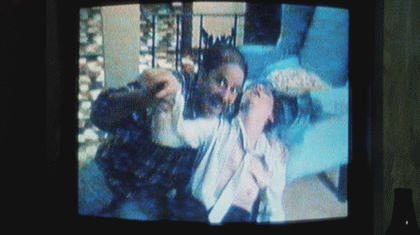 Tom Towles and Lisa Temple in HENRY's most notorious sequence: the "home video."
Tom Towles and Lisa Temple in HENRY's most notorious sequence: the "home video." Tell us what you’re up to now. According the IMDb, you’re adapting one of my favorite short stories, Flannery O’Connor’s A GOOD MAN IS HARD TO FIND.
Well, I was hoping to, but the producer on that has been rather hard to find lately, so that’s where that’s at. I’m really just enjoying teaching at Second City. It’s been a great second wind for me.
Let’s talk about a few of your other films. Your entry in the REBEL HIGHWAY series for Showtime in the ‘90s was GIRLS IN PRISON, and it was written by the great Sam Fuller, and his wife, Christa.
I was asked to be a jurist at the Brussels Film Festival. When they convened the jury for its first meeting, the President of the jury was Sam Fuller! I had not idea. There was a law back in the day when Sam was a journalist for the New York Graphic, a crime reporter, this was before the war, that defined criminal insanity. It was called “The McNaughton Law.” (laughs) Sam said to me “Know what the McNaughton Law is, kid?” I said, ‘Yeah, it was the law that defined criminal insanity, circa the 1840s.’ (Author’s note: the specific wording of the law was as follows: “that every man is to be presumed to be sane, and ... that to establish a defence on the ground of insanity, it must be clearly proved that, at the time of the committing of the act, the party accused was labouring under such a defect of reason, from disease of the mind, as not to know the nature and quality of the act he was doing; or if he did know it, that he did not know he was doing what was wrong.”) From that moment on, we were great pals. So when they asked me to do REBEL HIGHWAY, I said I’d do it under one condition, which was that they let Sam write it. Sam was just a lion of a man.
Your film THE HARVEST was a terrific, and very unsung, thriller. I did not see that big twist coming.
Well, it was a very interesting script and we did a lot of work on it before we shot. The original script was more toward “Ooga Booga Horror.” The writer was a young guy who thankfully was very open to reworking it. For me, I looked to the classic German fairy tales for inspiration and I saw it as a modern take on HANSEL & GRETEL. And we got an amazing cast: Michael Shannon, Samantha Morton, Peter Fonda, and the two kids, Natsha Calis and Charlie Tahan, were real finds, just terrific. The metaphor is that your parents want to keep your heart. They don’t want you to grow up and leave, on a deep psychological level. At least mine didn’t. (laughs) It’s still streaming on Showtime and is out on Blu-ray.
What was Peter Fonda like?
He treats the Queen of England the same way he treats the lowest PA. Peter is just a prince, a pleasure to have on the set.
Your 1996 film NORMAL-LIFE starred Luke Perry, who just passed, in a career-redefining role as a sociopathic cop. What are some of your memories of him?
What to say about Luke? He was a great guy and a much better actor than people gave him credit for. 90210 pegged him as a teen heart throb but he gave a very fine performance opposite Ashley Judd in NORMAL-LIFE. I also had the good fortune to work with him again on David Milch's HBO series, JOHN FROM CINCINATTI. We remained good friends over the years and this is such terrible news.
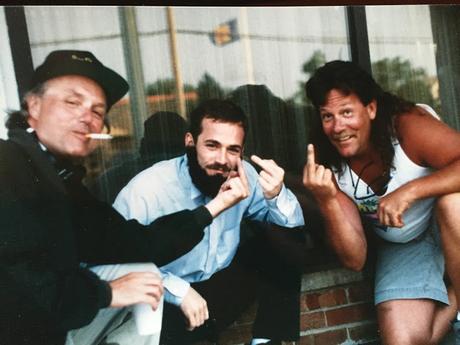 McNaughton (left) with the late Luke Perry (center) on the set of NORMAL-LIFE.
McNaughton (left) with the late Luke Perry (center) on the set of NORMAL-LIFE.